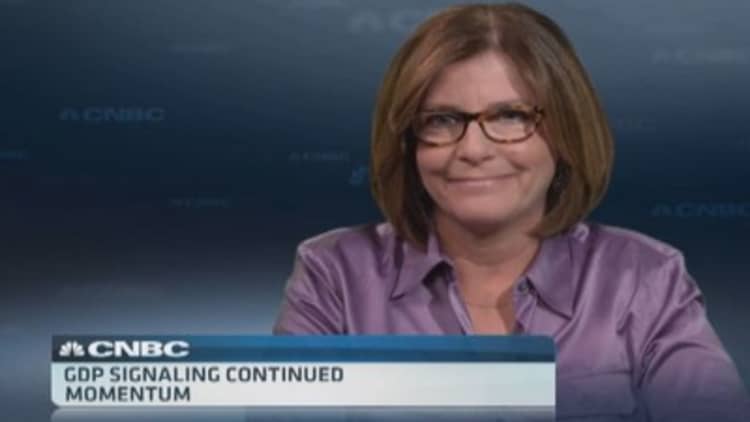
Even with a big drag from the government and a surprise drop in housing construction, the economy still managed the best second-half growth in a decade last year.
"Right now we average 3.7 for the back of half of the year. That's better than anybody thought was possible as late as early December," said Joseph LaVorgna, Deutsche Bank's chief U.S. economist.
The government reported Thursday that the gross domestic product grew by 3.2 percent in the fourth quarter of 2013, in line with expectations. Two big contributors were personal consumption expenditures and exports.
But what it says about the first quarter of this year is not clear, as economists expect cold weather and snow to play havoc with January's economic reports.
"It was such an unusual report. You had disproportionately much more weakness in construction and government spending. I would think the weather weakness in construction will reverse in Q1, maybe in February and March," LaVorgna said.
Government spending was down 4.9 percent in part because of the 16-day government shutdown and a 14 percent reduction in defense spending. That resulted in a 0.9 percent drag on GDP, which economists could explain away.
But more of a concern was the nearly 10 percent decline in residential construction. LaVorgna had expected it to add 0.8 percent to growth but instead it created a drag of 0.3 percent.
"Maybe it's weather. We need to give it another quarter to sort itself out," said Chris Rupkey, financial economist at Bank of Tokyo-Mitsubishi. He said construction could also have been affected by higher rates, but he does not expect the impact to linger and noted that housing starts were strong in November.
LaVorgna also pointed out that the drop was at odds with strength in home builder confidence. It has not become depressed and was reported at 56, down just slightly from 57 in December. The December reading was revised down from an initial 58, the highest level since August.
LaVorgna, who had forecast 4 percent growth for the quarter, said he will not change his forecast for the subsequent revisions. Third quarter GDP was ultimately revised to 4.1 percent growth from the government's initial estimate of 2.8 percent. He expects more than 3 percent for the first quarter, while a number of economists are more in the 2.5 percent range.
"We're lucky we got a solid 3 percent number. It kind of clears the air," said Rupkey. "If the jobs data is strong, that's OK, but if the jobs data is more mixed but GDP comes back, then we and the Fed can lean on that and say progress in the economy has been made. It's a good outcome today. A good result."
Some economists were skeptical of other details within the number. The export figure, for instance, helped add 1.3 percent to GDP. Exports rose 11.4 percent and imports were up 0.9 percent.
(Read more: )
"Such a combination is unlikely to prove a sustainable source of growth in 2014," wrote Barclays economists. "Inventories added 0.4 [percentage points]. Alongside the 1.7pp addition in Q3 (and sizeable contributions in Q1 and Q2 as well) this adds up to a very significant inventory build during 2013 (at least based on the current data vintage, the picture may look rather different following future revisions)."
Inventories were cited as a potential headwind by several economists. "Inventories jumped in the third quarter and then followed by even more accumulation in the fourth. Farm stocks have been a big part of the rise," wrote Citigroup economists. "While we think the gains in inventories represent a catch-up to rising demand, the $128 billion total change seems unsustainable."
Citigroup economists also point to the trade growth as unsustainable and inventories at levels that will not be maintained. "Today's report, while an indication of continued improvement in economic activity, suggests that growth at the start of the year may slip to the 1½ percent to 2 percent range," they noted. They added they expect growth to continue to strengthen toward the 3 percent range for all of 2014.
An important number that has been showing improvement is the real final sales of domestic product, which rose to 2.8 percent in the fourth quarter, compared with an increase of 2.5 percent in the prior quarter.
—By CNBC's Patti Domm. Follow her on Twitter @pattidomm.


